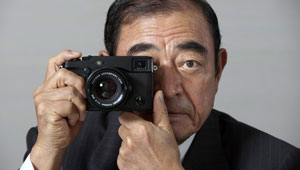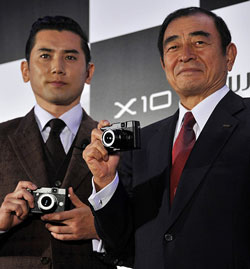Germany’s Frankfurter Allgemeine Zeitung (FAZ) has an in-depth interview with Fujifilm’s president Shigetaka Komori, the concern director who ushered in the reorganization of Fujifilm — just to mention the introduction of two nutrition and cosmetics product lines in 2006. What, you ask, has a traditional film company to do with nutrition and cosmetics?

Japan’s large film producer is reorganizing its core businesses. The classic film business has become irrelevant, says Komori. The company’s future rests on cosmetics and pharmaceuticals. Only 1% of annual turnover comes from its traditional film business. And yes, Fujifilm really wanted to buy Olympus. But not Leica.
And they’re into Alzheimer’s disease and skin care products. Didn’t you always want to know what film has to do with human skin? Antioxidants, we learn, are not only preventing the fading of photos. The can also curb the aging of human skin. For Fujfilm’s new business model film and skin become one and the same.
Here’s the translation of the interview published on May 25, 2012.
Mr. Komori, are you still taking pictures?
Of course.
What kind of camera do you use?
Currently, the FinePix X100 is my favorite. I have the device with the serial number 1. That’s what I wanted.
Why?
This is one of the best cameras that I’ve ever had in my hands.
With this model, Fujifilm packed modern digital technology in a design from the fifties.
That catches on.
Why didn’t you then buy German company Leica, as a few years ago the brand was up for sale?
We have been thinking seriously about it. But we decided against it.
Why?
Because it would not fit into our strategy. We then set about to rebuild Fujifilm.
And the luxury brand Leica wouldn’t fit in your portfolio?
Leica is a premium brand, and I admit when something is for sale that is tempting. But Leica has a different business model. From the Fujifilm sensor to software and all the important components we produce all ourselves. We too have a very good brand. So why should we put Fujifilm technology in an envelope from Leica.
Why not? That’s what many are doing. Apple computers are manufactured by Foxconn, Sony television sets came from Samsung.
I think our decision to not purchase Leica is a very honest one. At the time we wanted to develop new business segments, and this is what we’ve done. Leica would not really fit into it.
With Kodak the market leader in the film industry just went into bankruptcy. Agfa is a shadow of its former self…
… but Fujifilm is growing.
Japanese companies like Sony, Matsushita and Olympus however are stuck in a bind between a strong currency and high commodity prices.
Export-oriented Japanese companies like Sharp, Sony and Olympus currently face difficulties. They fight with a strong yen. The government needs to intervene.
The government?
Yes. Tokyo must take action. The market seems to not work properly. Supply and demand do not fit anymore. Or why do you think, why have the Swiss capped the franc?
Because the franc appreciated massively due to the huge inflows of cash.
Exactly. And that had little to do with the state of the real Swiss economy. The franc values far too much for the country’s export-oriented firms. That can destroy a lot. We are in a similar situation. It’s almost like in the mid-eighties.
At that time, the Americans asked to the negotiating table.
At that time Washington thought the dollar was too strong. Tokyo was forced to revalue the yen significantly. Today we again see a disproportionately strong yen. Since the crisis, the U.S. bank Lehman Brothers revalued the yen 35% higher. A company can’t just put that away.
But companies like Sony and Olympus also have domestic problems?
Of course, the companies have to do their homework. And at least at Olympus much was misdirected. They have a problem with their equity. That’s too weak with only 4-5% of total assets.

That makes Olympus vulnerable. Their business with endoscopes would fit well with Fujifilm. Why didn’t you grab the chance?
We were ready.
So Olympus wouldn’t want to sell?
Olympus continues to be a publicly traded company, which is associated with Mitsubishi Tokyo and Sumitomo Mitsui, two powerful banks. We would have a different situation if Olympus would have left the stock exchange.
The opportunity is gone?
Well, we have made Olympus an offer for cooperation. At the end of April they appointed a new management team. They have to decide now.
What’s the offer?
I don’t want to say anything about this now.
A takeover is no longer on the table?
If I were in Olympus’ management I’d spare no effort to remain independent.
You did not want to buy Leica, you could not buy Olympus. Where do you want to go with Fujifilm?
The movie business is our root, and this will remain so. But we redefined the business. In times of massive digital photography the classic film almost disappeared from the market. Just look what happened to our former competitors.
Again, where do you want to go?
We are still very successful in the business with cameras, lenses and photography books. And don’t forget printers and office equipment. Decades ago we entered the medical field with X-rays. Ten years ago we decided to further evolve these development paths.
What exactly did you do?
We repositioned the company. Six years ago we have given us the structure of a holding company. Over the past ten years we made specific purchases and invested 6-8% of our revenue in research and development. That is a very high rate, even for a Japanese company.
And what is the result?
The result is today we have six business areas in which we can grow strongly: Medical Systems, Graphic Systems, Optical Devices, Office Communications, Digital Imaging and Functional Materials. All these areas are in one way or the other connected with film technology.
In what way?
Well, the business of photographic films is very complex and very complicated. Just look what techniques and technology are necessary to produce film. Film has over a dozen layers of paint applied to a substrate. Not one layer is allowed to pass into the other. We’re talking about precision work with about a hundred highly functional materials. That’s a major technical achievement. It takes experience, methods and patents, which can then be used beyond the photographic film.
But these technical achievements have been done by others as well.
Sure, but we consistently developed it further. We entered the business with beauty, we’re engaged in nanotechnology and biotechnology as well as in the pharmaceutical business.
What’s the point?
What’s the point? This gives us flexibility. Our business stands on a broad, basis. Today we make perhaps 1% of our sales with traditional photographic film.
What is Fujifilm doing in the pharmaceutical sector?
We currently have two promising drugs in development. One to treat Alzheimer’s disease, one against influenza.
To treat Alzheimer’s? Nobody has a therapy for Alzheimer’s disease.
Alzheimer’s is a terrible disease. Some 65 million people in the world suffer from it. And you’re right, no one has a lasting remedy. But we try, we struggle against it, and we now have a drug that is in America in the second clinical trial phase. The medicament is in a position to connect synapses in the brain to each other again. This could lead to a huge step in the treatment of Alzheimer’s.
When will the drug become available?
As I said, we still need a third clinical trial phase and then even further tests are still necessary. If all goes well, we are in a few years on the market.
So Fujifilm will be a pharmaceutical company?
Not necessarily.
But if you offer drugs?
We already offer access to medication. We’re a contract manufacturer for various pharmaceutical companies. In addition we’re currently launching our skin care products under the brand Astalift in Europe.
Where then is your business focus?
Our core competence lies in research, development and technology. We come from the film business, and we are a film company.

What has the movie business to do with cosmetics?
A lot. The common element is the fine chemicals industry. Thanks to the film business we have over 200,000 chemical compounds in our database. For 75 years we’ve been working with collagen. This protein plays not only a role as gelatin in photographic films, it also plays an important role as connective tissue in the human skin. We also have experience with antioxidants, which not only prevent the fading of photos, but also can curb the aging of human skin.
And from this you have made skin creams?
It’s not that simple.
How difficult is it?
For example, you must handle the antioxidants properly.
And others are not able to do that?
We have about 4,000 of these chemical compounds. For our skin care line we chose astaxanthin. It’s the most powerful natural antioxidant, a natural dye — which, for instance, causes the red coloration of crustaceans.
Others are probably applying it as well…
One kilogram costs about $ 7,000. And if you have it, you still have to process it correctly. And that’s very difficult with astaxanthin. Here our experience with nanoparticles comes into play. What we have learned in the production of films can also be used for antioxidants, that is to shred these substances into the tiniest parts and then surround them with a layer. Only then can this substance unfold its effect.


